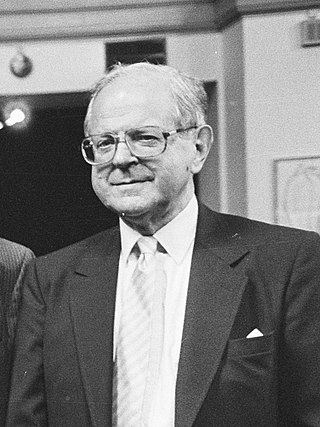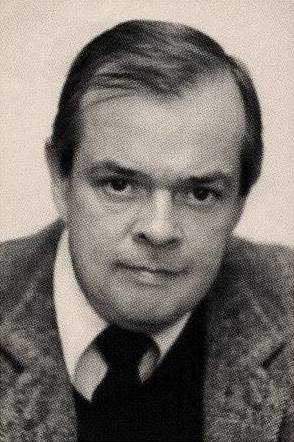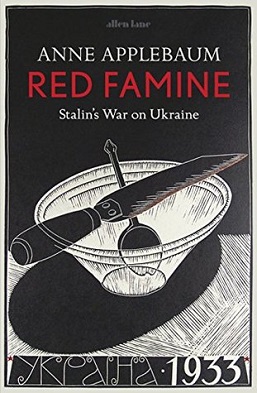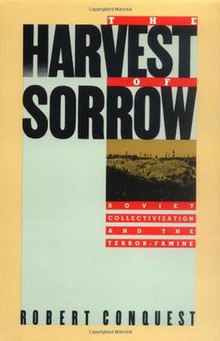
George Robert Acworth Conquest was a British and American historian, poet, and novelist. He was briefly a member of the Communist Party of Great Britain but later wrote several books against Communism.

The Soviet Union introduced forced collectivization of its agricultural sector between 1928 and 1940 during the ascension of Joseph Stalin. It began during and was part of the first five-year plan. The policy aimed to integrate individual landholdings and labour into nominally collectively-controlled and openly or directly state-controlled farms: Kolkhozes and Sovkhozes accordingly. The Soviet leadership confidently expected that the replacement of individual peasant farms by collective ones would immediately increase the food supply for the urban population, the supply of raw materials for the processing industry, and agricultural exports via state-imposed quotas on individuals working on collective farms. Planners regarded collectivization as the solution to the crisis of agricultural distribution that had developed from 1927. This problem became more acute as the Soviet Union pressed ahead with its ambitious industrialization program, meaning that more food would be needed to keep up with urban demand.

The Holodomor, also known as the Ukrainian Famine, was a mass famine in Soviet Ukraine from 1932 to 1933 that killed millions of Ukrainians and has been commonly described as man-made. The Holodomor was part of the wider Soviet famine of 1930–1933 which affected the major grain-producing areas of the Soviet Union.
Soviet and communist studies, or simply Soviet studies, is the field of regional and historical studies on the Soviet Union and other communist states, as well as the history of communism and of the communist parties that existed or still exist in some form in many countries, both inside and outside the former Eastern Bloc, such as the Communist Party USA. Aspects of its historiography have attracted debates between historians on several topics, including totalitarianism and Cold War espionage.

Throughout Russian history famines, droughts and crop failures occurred on the territory of Russia, the Russian Empire and the USSR on more or less regular basis. From the beginning of the 11th to the end of the 16th century, on the territory of Russia for every century there were 8 crop failures, which were repeated every 13 years, sometimes causing prolonged famine in a significant territory. The causes of the famine were different, from natural and economic and political crises; for example, the Great Famine of 1931–1933, colloquially called the Holodomor, the cause of which was, among other factors, the collectivization policy in the USSR, which affected the territory of the Volga region in Russia, Ukraine and Kazakhstan.
Douglas Tottle is a Canadian trade union activist and journalist, most notable for being the author of the book Fraud, Famine, and Fascism: The Ukrainian Genocide Myth from Hitler to Harvard, which is grouped as Holodomor denial literature by the United States Library of Congress.

The Soviet famine of 1930–1933 was a famine in the major grain-producing areas of the Soviet Union, including Ukraine and different parts of Russia, including Kazakhstan, Northern Caucasus, Kuban Region, Volga Region, the South Urals, and West Siberia. Major factors included the forced collectivization of agriculture as a part of the First Five-Year Plan and forced grain procurement from farmers. These factors in conjunction with a massive investment in heavy industry decreased the agricultural workforce. Estimates conclude that 5.7 to 8.7 million people died from starvation across the Soviet Union. In addition 50 to 70 million Soviet citizens starved during the famine yet survived.
Holocaust trivialization refers to any comparison or analogy that diminishes the scale and severity of the atrocities committed by Nazi Germany during the Holocaust. The Wiesel Commission defined trivialization as the abusive use of comparisons with the aim of minimizing the Holocaust and banalizing its atrocities.

James E. Mace was an American historian, professor, and researcher of the Holodomor.

Holodomor denial is the claim that the Holodomor, a 1932–33 man-made famine that killed millions in Soviet Ukraine, did not occur or diminishing its scale and significance.

The International Commission of Inquiry Into the 1932–1933 Famine in Ukraine was set up in 1984 and was initiated by the World Congress of Free Ukrainians to study and investigate the 1932-1933 man-made famine that killed millions in Ukraine. Members of Commission selected and invited by World Congress of Free Ukrainians. None of them represent own country or country authority/institution and act as individual. Most of them are retired jurists, one of them died before Commission finish their investigations. The Commission was funded by donations from the worldwide Ukrainian diaspora.

In 1932–1933, a man-made famine, known as the Holodomor, killed 3.3–5 million people in the Ukrainian Soviet Socialist Republic, included in a total of 5.5–8.7 million killed by the broader Soviet famine of 1930–1933. At least 3.3 million ethnic Ukrainians died as a result of the famine in the USSR. Scholars debate whether there was an intent to starve millions of Ukrainians to death or not.

Collectivization in Ukraine during the period when it was part of the Soviet Union, and was officially called the Ukrainian Soviet Socialist Republic, was part of the policy of collectivization in the USSR and dekulakization. It was pursued between 1928 and 1933 with the purpose to consolidate individual land and labour into collective farms called kolkhoz and to eliminate enemies of the working class. The idea of collective farms was seen by peasants as a revival of serfdom.

The causes of the Holodomor, which was a famine in Soviet Ukraine during 1932 and 1933 that resulted in the death of around 3–5 million people, are the subject of scholarly and political debate, particularly surrounding the Holodomor genocide question. Soviet historians Stephen Wheatcroft and J. Arch Getty believe the famine was the unintended consequence of problems arising from Soviet agricultural collectivization which was designed to accelerate the program of industrialization in the Soviet Union under Joseph Stalin. Other academics conclude policies were intentionally designed to cause the famine. Some scholars and political leaders claim that the famine may be classified as a genocide under the definition of genocide that entered international law with the 1948 Genocide Convention.

The Holodomor was a 1932–33 man-made famine in Soviet Ukraine and adjacent Ukrainian-inhabited territories that killed millions of Ukrainians. Opinions and beliefs about the Holodomor vary widely among nations. It is considered a genocide by Ukraine, and Ukraine's Ministry of Foreign Affairs has lobbied for the famine to be considered a genocide internationally. By 2022, the Holodomor was recognized as a genocide by the parliaments of 23 countries and the European Parliament, and it is recognized as a part of the Soviet famine of 1932–1933 by Russia. As of June 2023, 35 countries recognise the Holodomor as a genocide.
The Great Turn or Great Break was the radical change in the economic policy of the USSR from 1928 to 1929, primarily consisting of the process by which the New Economic Policy (NEP) of 1921 was abandoned in favor of the acceleration of collectivization and industrialization and also a cultural revolution. The term came from the title of Joseph Stalin's article "Year of the Great Turn" published on November 7, 1929, the 12th anniversary of the October Revolution. David R. Marples argues that the era of the Great Break lasted until 1934.

Kulak, also kurkul or golchomag, was the term which was used to describe peasants who owned over 3 ha of land towards the end of the Russian Empire. In the early Soviet Union, particularly in Soviet Russia and Azerbaijan, kulak referred to property ownership among peasants who were considered hesitant allies of the Bolshevik Revolution. In Ukraine during 1930–1931, there also existed a term of podkulachnik ; these were considered "sub-kulaks".

The Kazakh famine of 1930–1933, also known as the Asharshylyk, was a famine during which approximately 1.5 million people died in the Kazakh Autonomous Socialist Soviet Republic, then part of the Russian Socialist Federative Soviet Republic in the Soviet Union, of whom 1.3 million were ethnic Kazakhs. An estimated 38 to 42 percent of all Kazakhs died, the highest percentage of any ethnic group killed by the Soviet famine of 1930–1933. Other research estimates that as many as 2.3 million died. A committee created by the Kazakhstan parliament chaired by Historian Manash Kozybayev concluded that the famine was "a manifestation of the politics of genocide", with 1.75 million victims.

Estimates of the number of deaths attributable to the Soviet revolutionary and dictator Joseph Stalin vary widely. The scholarly consensus affirms that archival materials declassified in 1991 contain irrefutable data far superior to sources used prior to 1991, such as statements from emigres and other informants.

Red Famine: Stalin's War on Ukraine is a 2017 non-fiction book by American-Polish historian Anne Applebaum, focusing on the history of the Holodomor. The book won the Lionel Gelber Prize and the Duff Cooper Prize.










